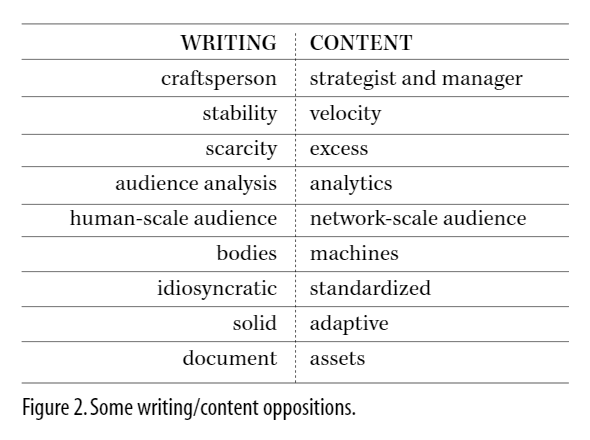A review of When Writing Becomes Content
Since the advent of the internet, there has been a quiet struggle for individuals to find ways to tame this new beast. Ideas and concepts such as managing a website blog or social media page are younger than many of the people who do such things. We may have gotten a grasp on the ideas and possibilities of such things, but as the technology continues to improve and grow, so too must writers both new and old adapt to the ever-changing landscape. And so, it is with this thought in mind that I look at Lisa Dush’s analysis of writing in the modern age in Writing as Content.
To start, Lisa’s analysis starts with this:
“This essay explores content, a word and concept now often associated with writing in fields including marketing, journalism, publishing, and technical communication…”
This immediately lets us know that this was a thought piece written with other professional writing contemporaries in mind for an audience. Of course, content in of itself is not specifically related to writing, but for the purpose of this discussion it is treated as an equal equivalent for argument’s sake. Following this introduction is a list of what Lisa would call the words defining content in this specific definition. The words Lisa decided to use are “conditional”, “computable”, “networked”, and “commodified”. “Conditional” represents the “fluidity” of the content; there are many shapes content can take especially by digital means and this word embodies that idea (Dush 176). “Computable” refers to the readability of content; it is how well the information of the content provided conveys itself to its audience. “Networked” is how the content gets to people. It involves things such as tags and metadata that allow the content to reach as many eyes as possible.
Finally, there is “commodified” which is how the content is used as an “asset” (Dush 177). This factor focuses on how to market the content to become the best product it can be.
After explaining these four words, Dush then takes some time to talk about writing and content metaphors. In particular, Dush references the essay “Blinded by the Letter: Why Are We Using Literacy as a Metaphor for Everything Else?” where the main argument is that using the word literacy to substitute for computer or digital know-how could lead to “problematic accusations” (Dush 179). Though I can understand wanting to use precise language when speaking on the subject of writing, I also find myself wondering if this particular portion of the essay needed to be dragged on as Dush begins to state that it may be best to use different words for differing professions based in writing for creating better opportunities. I agree with Dush’s prospect on its own, but I feel this argument does not further the conversation on writing as content in a direction the author had envisioned.
Moving past this, Dush speaks on multimodality and opposing viewpoints on writing and content complete with a diagram (Dush 182). Personally, I think the opposing viewpoints raise the question of “if writing is content, then why are they in direct opposition of each other in this chart?” Dush decided to treat digital writing as something that is fundamentally different from traditional writing which may be the case when trying to commercialize, but this is not an absolute by any means.

What follows amounts to an analysis that serves to validate the creation of the integrative studies as Dush talks about various content professions and quotes Content Strategy: Connecting the Dots Between Business, Brand, and Benefits and says, “Writers can’t be experts at everything related to content” (Dush 184). This is then followed with a diagram of content strategy (courtesy of Halvorson and Rach, Content Strategy for the Web) consisting of four quadrants and a “core strategy”. “Substance” and “structure” represent content components and “workflow” and “governance” represent people components. These elements represent the content loop that writers endure.

Following this idea, Dush questions how the idea of content writing can be taught as for many writers, what they learned in class was not what was normally taught. This has however been seeing some rectification in recent times as more and more programs have been added focusing on jobs centered around content. This is something I can thankfully say I am seeing firsthand and should only continue to improve with time.
Dush closes with a paragraph that states “As a single word, a metaphor, and a set of related practices, content offers a memorable way to keep some of the most important aspects of digital writing at the forefront of our teaching and research” (Dush 193). This sentence I believe does well making Dush’s thoughts on the matter of writing as content clear. Content writing is a change from traditional writing and likely has a very different audience, however, content writing can also be used as a device to make writing stand out in a new frontier of media. Personally, I see writing content as something that is flexible and Dush’s closing thoughts seem to also agree with that sentiment. Dush’s analysis was quite thoughtful and had the insight of someone with a close eye on the inside of the writing circle. As a writer myself, it was an interesting read seeing such a perspective.
Lisa Dush’s essay can be read in full here.
References
Dush, L. (2015, December). National Council of Teachers of English. Retrieved January 30, 2021, from https://library.ncte.org/journals/CCC/issues/v67-2/27641